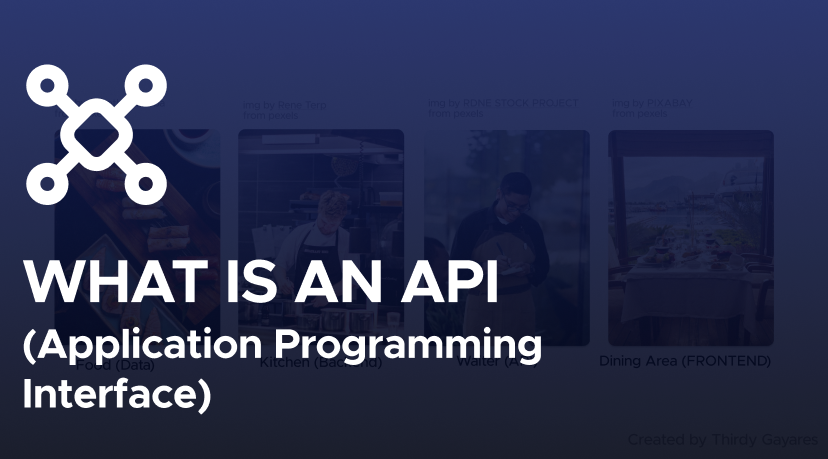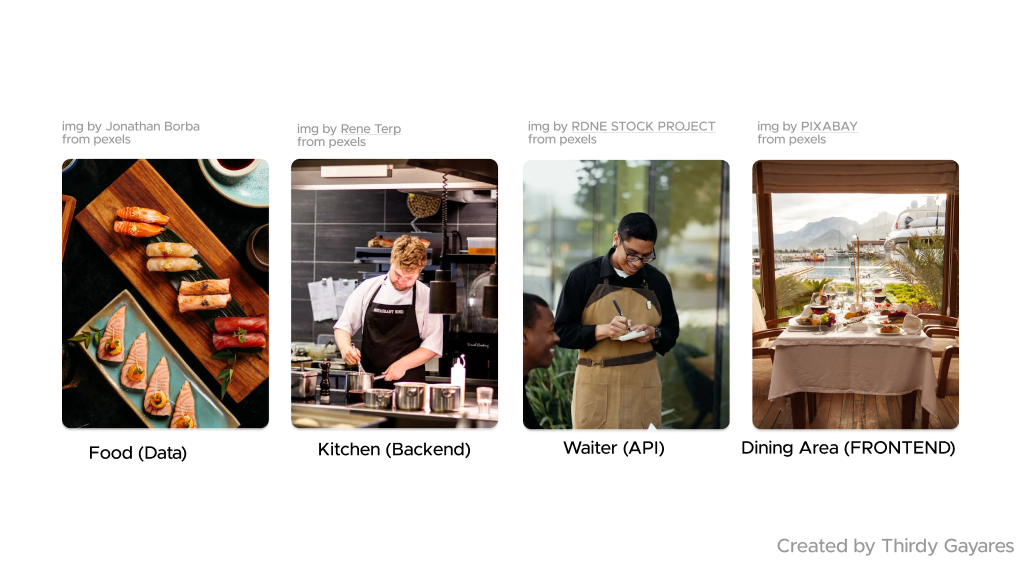What is an API?
 Thirdy Gayares
Thirdy Gayares
An API (Application Programming Interface) is a way for different software systems to communicate with each other. APIs allow one program (the client) to request data or perform actions from another program (the server) over the internet. Think of an API as a bridge that enables two applications to exchange information without direct human interaction.

Let’s use a restaurant as an analogy to explain how an API works:
Kitchen (Backend): The kitchen (or the chef) is where the food is prepared, much like how the backend server processes data and performs the main functions of an application.
Waiter (API): The waiter acts as the middleman between the customer (frontend) and the kitchen (backend). When the customer makes a request for food (data), the waiter takes the order, communicates it to the kitchen, and then delivers the prepared dish back to the customer. This is similar to how an API communicates between the frontend and backend, fetching or sending data.
Food (Data): The food represents the data or information that is requested by the user. The kitchen (backend) prepares the food (data), and the waiter (API) delivers it to the customer (frontend).
Dining Area (Frontend): The frontend is the part of the restaurant where the user interacts with the environment, like the dining area and menu. It's what the user sees and interacts with, such as a website or app interface.
In this analogy, the frontend is the part of the restaurant that the customer interacts with, like the menu or seating area. It's where the customer makes a request (like placing an order), similar to how a user interacts with a website or app to request data.
To sum up:
Kitchen = Backend (server)
Waiter = API
Food = Data
Dining Area = Frontend (user interface)
Customer = User (person using the app)
How Does an API Work?
APIs typically operate using the HTTP protocol, which is the same protocol used for browsing websites. When an API request is made, it contains several parts:
URL: The address of the resource you’re trying to access.
Method: This specifies the action to be taken, such as retrieving data (GET) or submitting new information (POST).
Headers: Extra information, like the type of response expected (JSON or XML) or authentication details.
Body: The actual data sent in the request, such as a search term or form data(freeCodeCamp)(freeCodeCamp).
For example, if you are using an API to fetch weather data, the client sends a GET request to the server's URL, and the server responds with the requested weather data. If successful, you receive a status code like "200 OK" to indicate the request was fulfilled(freeCodeCamp).
Types of APIs
There are several types of APIs:
Open APIs: Available to the public, often used for tasks like getting weather data or pulling stock information.
Internal APIs: Used within a company to connect internal systems.
Partner APIs: Shared between business partners for specific tasks, like payment processing.
Composite APIs: These combine multiple requests into one, making the process more efficient(freeCodeCamp)(freeCodeCamp).
Why Are APIs Important?
APIs allow developers to integrate different services into their applications. For example:
Social Media APIs (like the Twitter API) let developers integrate tweets and social feeds into their apps.
Data APIs (such as weather or financial data) let developers incorporate real-time information from other platforms(Springboard)(SimpleLocalize).
APIs are vital tools for modern software development, enabling seamless integration between various services and platforms, making the development process faster and more efficient.
Subscribe to my newsletter
Read articles from Thirdy Gayares directly inside your inbox. Subscribe to the newsletter, and don't miss out.
Written by

Thirdy Gayares
Thirdy Gayares
I am a dedicated and skilled Software Engineer specializing in mobile app development, backend systems, and creating secure APIs. With extensive experience in both SQL and NoSQL databases, I have a proven track record of delivering robust and scalable solutions. Key Expertise: Mobile App Development: I make high-quality apps for Android and iOS, ensuring they are easy to use and work well. Backend Development: Skilled in designing and implementing backend systems using various frameworks and languages to support web and mobile applications. Secure API Creation: Expertise in creating secure APIs, ensuring data integrity and protection across platforms. Database Management: Experienced with SQL databases such as MySQL, and NoSQL databases like Firebase, managing data effectively and efficiently. Technical Skills: Programming Languages: Java, Dart, Python, JavaScript, Kotlin, PHP Frameworks: Angular, CodeIgniter, Flutter, Flask, Django Database Systems: MySQL, Firebase Cloud Platforms: AWS, Google Cloud Console I love learning new things and taking on new challenges. I am always eager to work on projects that make a difference.